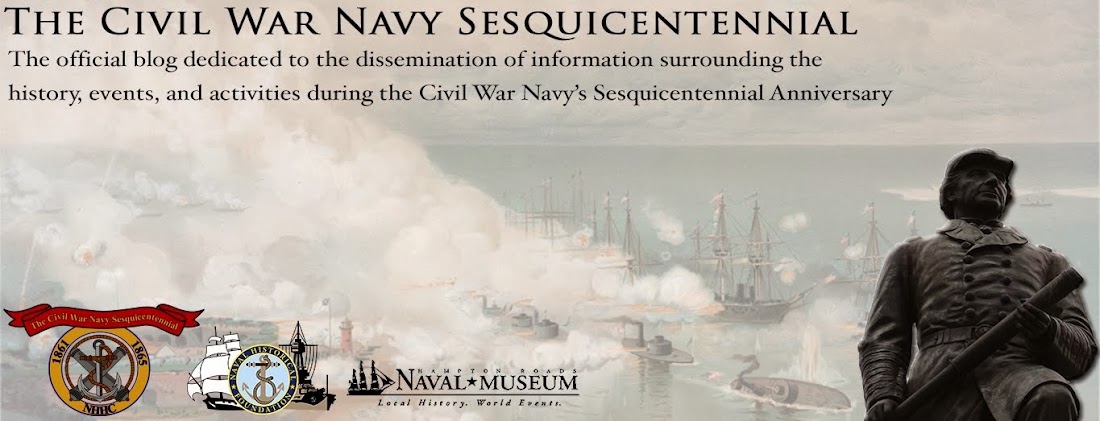6 June marks the 150th anniversary of the Battle of Memphis. The short yet decisive battle was one of the only fleet vs. fleet actions during the American Civil War. NHHC defines a "Ram" as a "ship whose principal weapon is its own bow, hardened and reinforced to penetrate the hull of an enemy ship, and usually strengthened internally to avoid or reduce self-inflicted damage from the collision."
This post, focusing on the technology of naval warfare, is part of the "Iron Men Afloat" series with the Civil War Monitor blog. Make sure you check out fellow CWN 150 guest blogger Craig Swain's post on Marker Hunter.
______________________
The fleet that steadily approached the Memphis levee was a powerful one. Much in the same taste of the Confederate River Defense Fleet, the Union navy christened their five ironclad warships operating along the upper Mississippi in homage to the great river cities of the North. Flag Officer Davis, commanding the flagship Benton, trekked alongside the USS Carondelet, St. Louis, Cairo, and Louisville on their way to Memphis with an air of confidence bordering egotism. The newly installed leader intended on commanding the Western Flotilla “like an orchestra without an instrument out of tune,” devoid of outside distraction or influence. These gunboats, built by acclaimed St. Louis engineer and Mississippi River salvager James B. Eads, were strong and powerful but lacked some early inefficiency in design and speed. If the Federal War Departments “listened attentively” to Eads’ design, the Mississippi River Ram Fleet functioning alongside Davis was the exact opposite.
The newly formulated Ram Fleet commanded by Charles Ellet, Jr. matched well with the eight Confederate rams. The Ram Fleet that Secretary of War Edwin M. Stanton commissioned Ellet to develop in April encompassed his vocational skills by converting Ohio River steamers into faster and stronger counterparts to the River Defense Fleet. Given the character of Ellet’s design, one might assume Federal Secretary of Navy Gideon Welles would accept the new plans at face value. Quite the contrary, Welles never completely accepted Ellet’s concept of a ramming fleet, and summarily dismissed the idea in favor of John Ericsson’s Monitor design. Moreover, Welles wrote in his personal diary that Ellet himself could not be trusted because he was “not a naval man,” leaving Secretary of War Stanton as the only person who acknowledged the idea in early 1862. It was not until the CSS Virginia’s deadly discourse with the USS Cumberland that many officials in Washington started to take Ellet serious. Stanton invited Ellet to Washington on 14 March for a preliminary discussion of details and supplies. Inevitably, Stanton would use the guise of the War Department to construct, outfit, and run Ellet’s project.
Seeing the success of the Confederate ironclad Virginia’s first day performance at Hampton Roads in early March, officials in Washington grew convinced that Ellet’s design might provide the answer to the Confederate naval forces in the west. Reports from Major General Henry W. Halleck in the West speculated that the Confederates had “one or more river boats [. . .] like the Merrimack” in New Orleans increasingly hastened the necessity of immediate action. Ellet did not personally care for Ericsson’s Monitor design in the wake of its clash with the Virginia, and instead stood convinced his enterprise superior. His 1855 pamphlet on the use of steam-driven rams, which fell on deaf ears during the Crimean War and the Civil War’s outset, finally came to fruition when its implantation proved more important than ever.
These rams, ranging from 170 to 180 feet in length, used 12 to 16 inches of iron-braced timber to reinforce the ramming bow. Ellet’s one directional design intended to use the entire weight of each vessel to crush opposing forces upon impact, akin to the Greek triremes of antiquity. Ellet was extremely confident that the aid of the Mississippi River current would “run these rams into them, and if possible, sink them.” Indeed, Ellet’s background as an author of several studies of flood control on the Mississippi and Ohio Rivers further solidified his pronounced expertise. With four rams ready for service by the beginning of May, the Union navy now possessed both firepower and ramming speed.
For sources and more information, please email the author at matthew.t.eng@navy.mil.



No comments:
Post a Comment